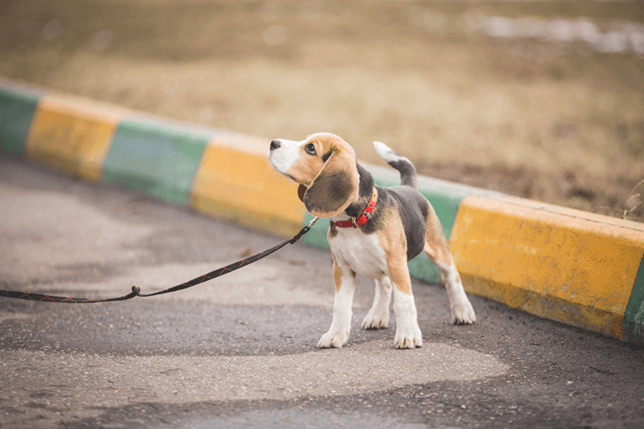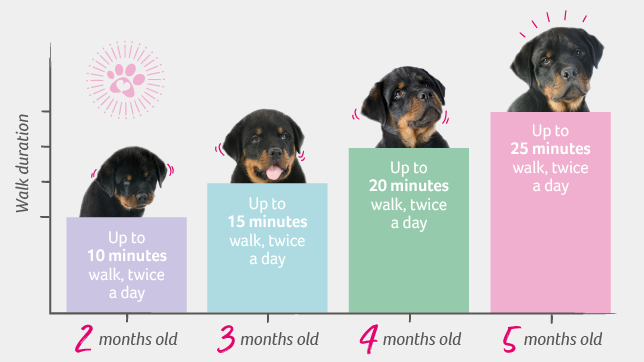1st February 2022
How far is too far?
So, you have a new pup and you’re ready to head out and about to let your dog explore their new surroundings. Wait! Before you do, you’ll need to make sure your new canine companion is ready for the great outpaws.
There are plenty of adventures to be had in your new life together but for now, make sure you give your puppy the appropriate amount and type of exercise. Here’s a guide from the vet experts at Joii on exercising a new dog, how far is too far and what problems can arise if they’re walked too much too soon.
When can I take my puppy for their first walk?
It’s advised that you don’t take your dogs into public places until they’re fully protected by their vaccinations which is usually a week or so after their second jab. This can vary depending on which vaccine your puppy was given so it’s best to confirm timelines with your vet.
Here are some top tips on how to reduce the risks of infection in your pup if they’ve not received all their necessary vaccinations:
- You can walk them in non-doggy areas.
- Don’t allow them to mix with dogs of unknown vaccination status.
- Avoid parks or areas that other dogs have fouled.
- Carry your puppy when necessary to avoid unwanted contact from other dogs.
- Socialise your puppy with fully vaccinated (and friendly) dogs at home.
It’s beneficial to start taking your puppy out early so they can start to become familiar with all the different sights, sounds, textures and smells. If you have a driveway, garden or small patio at the front of the house, this is the perfect place to begin your training by simply sitting out there with your puppy on their lead, collar and harness. This gives them a chance to watch, sniff and explore whilst offering them some tasty treats to reward their good behaviour and reinforce it as a positive experience.
Make sure you leave the front door open at this stage so that if your puppy is feeling overwhelmed, they can head back into a place of safety and try again once they are calm again.
Remember: It is important to introduce new sights, sounds and smells slowly.

Exercising your puppy before they are fully vaccinated
Don’t worry, you can still keep your dog mentally and physically stimulated before they’re able to go and properly explore the world. Play and socialisation is just as important as walks for dogs of all ages.
Puppy classes
Puppy classes are a great place to start and should be considered as early as possible. Most classes will accept puppies from their first vaccination. Provided that appropriate disinfection of floors and equipment is done, the benefits of this socialisation will far outweigh the small risks of catching diseases from other puppies.
Play
If you have a garden, you can use this space to run around in with your pup or let them blow off some steam in a safe room of the house. You could make dinner time interesting by stuffing a Kong or using a food-dispensing toy.
Games such as tug of war, hide and seek, and retrieving games can all be great ways to help keep their minds busy while they’re confined to their home.
Remember: However you decide to entertain your pup, play should not replace exercise once they’re able to do so safely.
Training
Why not use this time to start teaching your pup the basic commands whilst they are young? This will likely result in a happier, well-behaved pet who will be more confident later in life and have the skills to cope with the different situations they might have to experience.
Taking your puppy for their first walk
Once your pup is fully protected from all the possible nasties, you might be wondering how much exercise your dog actually needs.
A general guide for exercising puppies is to allow them one to two sessions of five minutes walking for each month of age. So, for example, a four-month-old pup could enjoy walks of 20 minutes at a time, once or twice a day.

Continue this until they are fully grown and are of an age where their bodies can handle much longer walks and more strenuous activity.
Remember: Just like children, puppies tire more easily, so if they sit or lie down to rest on a walk, let them.
What about large or giant breeds?
Using the five minutes for every month guide still works for large and giant breeds of dog just as it does for their smaller counterparts, but big dogs take longer to reach maturity. If you have a bigger breed, you should check with your vet for advice on exercising but as a guide, don’t start taking them on long walks until they are at least a year old.
The importance of not overexercising a puppy
Too much exercise or forcing your pup to move when they’d rather rest, can overtire your puppy and potentially damage their developing bones and joints. Restricting your pup’s daily exercise to the recommended amount can help prevent any problems arising later in life from being over-exercised when they were too young.
Looking for more dog advice?
Find the information you need as we support you through every step of your journey with your canine companion.
Need puppy insurance?
Dog insurance can help cover the cost of veterinary treatment if your puppy gets injured or falls ill.
